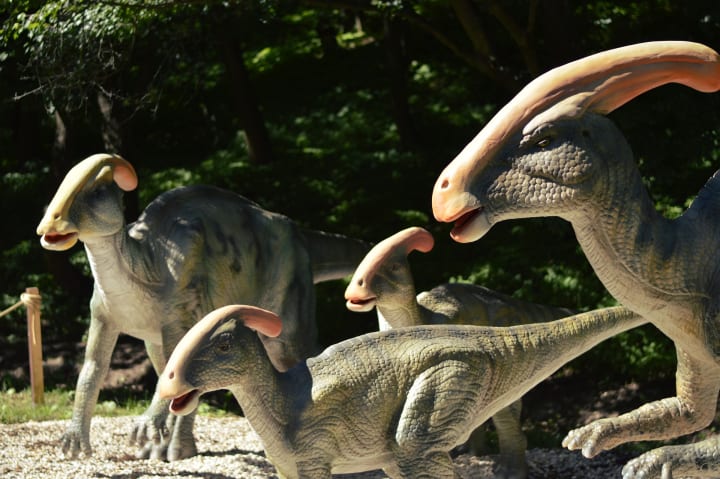Why did dinosaurs not produce civilization, but humans did?
This article discusses some of this issue and expresses some personal thoughts.

What are the foundations of civilization? brain. Asking "why can human beings produce civilization" is essentially asking "why the human brain can evolve to such a developed level".
Then there is a very crucial question: the starting point of the evolution of the human brain was not two million years ago. When primates evolved to the stage of Australopithecus, their intelligence far surpassed that of reptiles, birds and other mammals, and this brain was already extremely developed in the ape stage. Why is the primate brain so developed? We can start by asking: When is intelligence more useful?
1. The living environment is complex. It's easy to understand that the more complex the environment, the more useful it is of course to be smart.
2. Living in groups, the intensity of communication between gregarious creatures is far greater than that of solitary creatures, and it also requires a certain social structure, in which intelligence is more useful and easier to develop and evolve than solitary creatures.
Let's look at complexity first. The Cenozoic is an era when angiosperms flourished, and the diversity and complexity of angiosperms are far from that of gymnosperms, and the biological communities based on it are far more complex than the Mesozoic era dominated by gymnosperms (although we know Angiosperms appeared in the late Cretaceous, but after all, it was relatively short and not as prosperous as the Cenozoic) and any other era. The complexity of the plant community constitutes the first building block of the primate evolution towards intelligence. In a complex environment, it is very important for the brain to function well.
Then look at the group, and it is also very easy to understand. Primates, if not all, live in groups. OK, this condition is also met.
Then we ask again: But primates are not the only social animals living in the age of angiosperms, why are primates the winners of intelligence?
Because the primate's body features a special structure that promotes the evolution of intelligence - the hand. The division of labor and fine movements of the hand put forward higher requirements for the high differentiation of the cone system, further stimulating the evolution of the cerebral cortex. And why do primates have hands? Why do you need to grab something?

Primates have long lived arboreal and picking lives, and have special needs for grasping and fine motor skills. Some creatures, although arboreal, do not rely on fast climbing and picking like primates. For example, birds, although arboreal, do not have hands and do not rely on fine manipulations. Naturally, they lack direct evolutionary stimulation to the pyramidal system and cortical motor areas. Of course, the evolutionary efficiency of the brain is not as good as that of primates.
Speaking of this, some people will definitely ask the following questions: Birds evolved from dinosaurs, and dinosaurs were not arboreal at the beginning, why did the dinosaurs that climbed into birds not evolve, but the primates that climbed trees could have hands? Woolen cloth?
This starts with the evolution of the vertebrate spine.
The ancestors of terrestrial vertebrates were fish. What are the characteristics of the spine of a fish? You pick up the skeleton of a fish and break it, obviously, it can only bend left and right, not up and down. And our spine can bend in any direction. Why did the spine make this distinction in evolution?
Because swimming in the water, fish do not need to jump, the spine can not bend up and down is not a problem. When fish just came ashore and evolved the earliest ancestors of amphibians and reptiles, just like today's lizards and crocodiles, the spine can't move up and down. There is no way, after all, evolution has to come step by step.
But the problem comes right away. You observe the running of the beasts in the animal world. The beasts running fast, the back is constantly undulating, which is an inevitable phenomenon of four-legged running. Therefore, a spine that cannot bend up and down cannot support a body that can run on four legs at high speed. Therefore, the early amniotic animals could only walk on all fours and sway their bodies from side to side. This movement method inevitably compresses the lungs and affects ventilation, and the efficiency of running is greatly limited.
There are two solutions. Synapsids, the ancestors of mammals, and Sauriformes, the ancestors of dinosaurs, took two different routes. The Synapse evolved a spine that can move up and down, laying the foundation for high-speed running, just like today's quadrupeds. And the Sauriformes developed to the stage of dinosaurs, and adopted a plan to strengthen the bipedal walking on the hind limbs. Isn't your spine unable to move up and down? Then I can stand up and run on the back foot alone, and the inability of the spine to move up and down will not be a problem.
Which of the two options is better?
Strengthening the bipedal walking of the hind limbs liberates the forelimbs, so that the forelimbs do not need to continue to be restricted by the load-bearing function. Therefore, the forelimbs of the theropod dinosaurs have more flexible evolution space. At the stage of hand raptors, they evolved Wishbones and feathers laid the foundation for future evolution to birds, and eventually wings. So it's no accident that birds evolved from bipedal dinosaurs.

But the price the bird pays is forever lost the chance of evolution. Birds can fly, rely on claws and wings, and can move around trees with great ease, so there is no longer the selective pressure to evolve their grasping forelimbs. No matter how long a bird lives in trees, it will not evolve to shoot.
Mammals are different. In order for the flightless quadrupeds to maintain strong enough athletic ability in their arboreal life, they must climb, collect fruit, and pick. This requires first of all good mobility of the spine, and at the same time, it needs to be able to "grab". As it happens, the spine of Synapsium can move up and down, left and right, and is completely soft. At the same time, the needs of climbing and picking have also formed a strong selection pressure on the evolution of opponents. So the forelimbs of arboreal primates evolved hands, which in turn stimulated the evolution of the cortex.
Once the evolutionary path is determined, you cannot overthrow it. Hundreds of millions of years ago, the evolutionary routes of Sauriformes and Synapsids in solving the problem of running diverged, and in some way, their final outcome was determined.
About the Creator
Norma Noldo
I mainly write introductions about new technologies, long and short stories, and occasionally some personal experiences. Follow me if you like!
Enjoyed the story? Support the Creator.
Subscribe for free to receive all their stories in your feed. You could also pledge your support or give them a one-off tip, letting them know you appreciate their work.






Comments
There are no comments for this story
Be the first to respond and start the conversation.